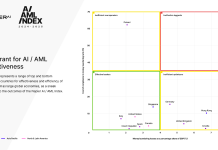There’s a revolution happening in the world of technology, and it’s making waves in our society. AI Large Language Models (LLM), such as ChatGPT, have dramatically changed our interaction with technology, sparking both intense excitement and lingering fears of an AI uprising.
This technology isn’t limited to tech start-ups. In fact, Fortune 100 companies are also jumping on board, integrating ChatGPT into various products, including recommendation engines and customer email auto-responders. However, some applications are proving more impactful than others.
Risk screening and investigations platform Quantifind has released a whitepaper exploring the practical use cases of AI language models within risk and compliance.
One such powerful application is in risk and compliance. LLMs are demonstrating their value in identifying financial crimes, spotting money laundering, and even exposing foreign influence in our economic markets. In an industry struggling with high transaction volumes, complex networks, and increased government regulation, the potential for LLMs to automate much of the Anti-Money Laundering (AML) / Know Your Customer (KYC) process is very appealing. In fact, LLM techniques are already being put to work in top-tier banks and government applications, reducing false positive alerts and enhancing automated decision-making.
Nonetheless, incorporating ChatGPT into an anti-money laundering or fraud prevention/detection system is no simple task, it said. Any AI solution needs to be part of a comprehensive system to achieve meaningful results and comply with FinCEN regulations. LLM stacks do have features that can be effectively harnessed into a next-generation AI solution for AML compliance and threat analysis. These components are already being incorporated into transaction monitoring, alerts triage, and perpetual customer due diligence for AML solutions.
Understanding how LLMs can enhance financial crimes compliance requires an examination of two key aspects. First, the efficiency gains from AI language models such as improvement in model development time with synthetic training data. Second, their use in streamlining the generation of Suspicious Activity Report (SAR) narratives.
If risk factor extraction is performed correctly using these techniques, then a profile for each entity, their transactions, and the risk associated with the entity across public domain data sources can be created. This profile can be summarised automatically using LLM. The LLM model can be further trained on actual SAR filings, making it possible to mimic SAR narratives more accurately.
While the applications of AI language models and LLM techniques in risk and compliance are promising and thrilling, they demand domain-specific accuracy, knowledge, and speed at scale. It’s vital to recognise that these AI innovations will form part of a broader solution, which will require the “proper systems, processes and professionals” that ChatGPT wisely advises.
Find the full whitepaper here.
Keep up with all the latest FinTech news here
Copyright © 2023 FinTech Global











